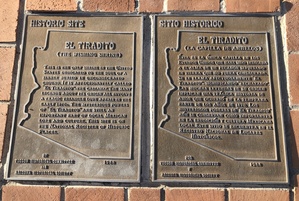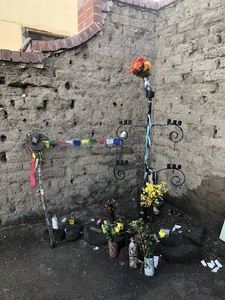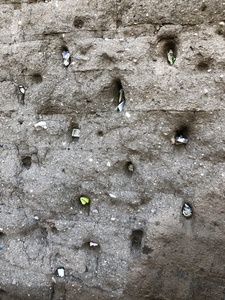 Photo courtesy of Borderlands History
Photo courtesy of Borderlands History
Introduction
In the Barrio Viejo or more commonly known as the "Old Neighborhood" in Tucson, AZ. Tucked away in a quiet corner are the remains of a brick building, decorated with candles and overgrown vegetation. There is a unique monument that still stands today. It is one of a kind, and closely resembles something out of a Hollywood movie. The attraction is frequently visited by many locals, most often by writers. The monument is called El Tiradito, it is a Catholic shrine built in 1871, the only one left in the United States of America. Not only that, the Catholic shrine is also distinctive as it is dedicated to the soul of a sinner instead of a saint. The unfortunate demise of Juan Oliveras is a blend of historical fact and local legend that builds on to the Southwest lore. In the Southwest region where the international border meets, "folk saints" are often held with a high standard alongside the Virgin of Guadalupe and family patron saints. Therefore, this makes it difficult for individuals to pray and seek guidance from a sinner.
 Photo taken by Paige Helfinstine 10/28/18
Photo taken by Paige Helfinstine 10/28/18
Background
According to legend, an 18-year-old man by the name of Juan Oliveras fell in love with his mother-in-law, who was renowned for her beauty and allure. In most reiterations of the story, it is said that his father-in-law, who happened to be one of the wealthiest and most powerful men in town, is also his employer. Despite the social disapproval and the risks involved, Juan and the employer's wife still started a secret relationship. The employer eventually caught Juan Oliveras and his wife in his bed together. After a verbal and physical confrontation, Juan ran out the front door while screaming for help. Unfortunately, the father-in-law caught up to him and pinned him down. He was furious and murdered Juan in a fit of rage. It is good to note that the stories may vary as to how he was killed, most saying he was axed or stabbed to death thus making that part of the story more folklore than fact. He then dragged Juan's corpse to the spot where El Tiradito shrine is situated today and abandoned it there, hoping that it would serve as a stern warning for anyone who dared to step near his wife ever again. The employer knew that he would be punished for the gruesome crime he had committed so he got on his best horse and fled South towards Sonora, Mexico where he hid. He attempted to go back to the North to reclaim his herd of sheep and bring them to Mexico, but he eventually met his end. You can say that it was karma because the way he died resembled the way he chopped up Juan. He was intercepted by a tribe of Apaches, they scalped and stabbed him to death. Later on, he was found dead, tied naked to a large Saguaro cactus along the Nogales to Tucson wagon trail.
Unfortunately, the miserable situation do not end there. On the same night of the murder, his mother-in-law was disheartened and depressed because of Juan's death. She eventually hung herself from the balcony of the grand Tucson estate. She was spotted hanging there by a passing freight wagon.
Some of barrio's residents made pleas to the Tucson Catholic Church Officials for Juan's corpse to be buried there but they refused due their beliefs and the sins that Juan has committed. The sin was that he had engage with another woman when he was already married to one. Juan Oliveras was eventually buried at the exact spot where he was cut down by his father-in-law. Fun fact, that's how the name of the attraction came about. El Tiradito directly translates to "The Castaway" or "The Little Throwaway".
The tension and pressure of Juan's actions caused Juan's widow desperation and hopelessness. At the time, she was pregnant with Juan's baby. She had to live in a large abandoned ranch because her parents and husband were dead from the incident. Ultimately, she couldn't take it anymore, she undid the knot of the rope of the bucket, going down into the ranches deep water well. The widow tied the rope around her neck, climbed onto the large rocks surrounding the well, and jumped down into the well, snapped her neck and killed herself. The neighbors only found her body a week later when they went to ask if she needed help moving to Tucson. Her burial site took place near the mesquite tree by the ranch, undisturbed to this date.
 Photo taken by Paige Helfinstine 10/28/18
Photo taken by Paige Helfinstine 10/28/18
Aftermath
Although the shrine was moved from its original site, the grotto that it now exists in has been its current location for close to 100 years, since in 1928 it was moved a block west to 420 South Main Ave where it currently lies discretely next to the El Minuto Cafe and a Tucson Mural. Some 50 years later, the Olivares’s buriel site and his shrine would be credited with stopping plans for a freeway that would have completely destroyed what was left of Barrio Viejo. In 1971, the folklore shrine was entered into the National Registry of Historical Places, because although he was a sinner he was also a lover, so many believed they needed to pay homage to a well loved martyr.
 Photo courtesy of Borderlands History
Photo courtesy of Borderlands History  Photo taken by Paige Helfinstine 10/28/18
Photo taken by Paige Helfinstine 10/28/18
The shrine is also known by another name, “The Wishing Shrine.” Many faithful leave candles, small tokens, or push notes and prayers into the cracks of the shrine’s adobe walls. It is said that some are asking for redemption from their own bad decisions and deeds, and others pray for the soul of Juan Olivares to leave purgatory. A visitor could spend an afternoon just admiring the various items and age that is shown on the adobe walls and dirt floor of the shrine to a sinner. Those that are superstitious may also believe in the "Curse of the Wishing Shrine." According to the Tucson Museum website, "It is said that if one visits with a clear open heart that forgives, they will pass, and they may even get their wish fulfilled. For others, it may just be the beginning of history repeating itself depending on what they themselves bring to the shrine. Also, it is said that if you light a candle at the shrine and it remains burning all night long without going out by sunrise, your wish may be granted depending on your motivations."
References:
Borderlands History - Tucson's Shrine to "El Tiradito", Jennifer Seman, June 26, 2014
El Tiradito (The Wishing Shrine), J. Makali Bruton, May 6, 2015
The El Tiradito - The Wishing Shrine Curse, Tucson Museum
Tucson Citizen: "Shrine to a Sinner", Romano Cedillos, October 28, 2004


